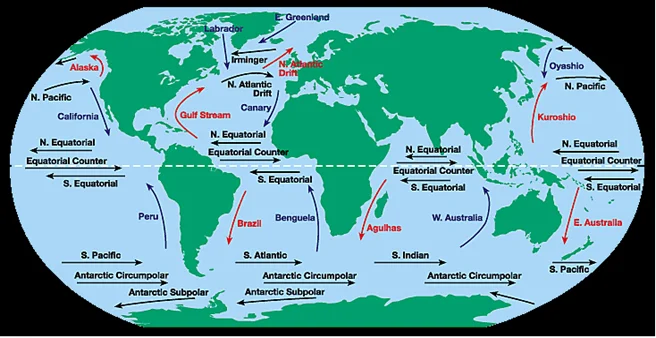Geography
Context: According to a recent study, cold ocean currents have sheltered the Galápagos Islands from global warming.
- Ocean currents are the continuous, predictable, directional movement of seawater driven by gravity, wind (Coriolis Effect), and water density. Ocean water moves in two directions: horizontally and vertically.
- Horizontal movements are referred to as currents, while vertical changes are called upwellings or down welling.
- This abiotic system is responsible for the transfer of heat, variations in biodiversity, and Earth’s climate system.
Overcoming Global Warming:
- The islands are protected from an otherwise warming Pacific Ocean by a cold, eastward equatorial ocean current and this current has been gaining strength for decades.
- The temperatures in waters along the west coast of the Galápagos have dropped by 0.5 degrees Celsius since the early 1990s.
- There’s a tug of war between global warming and the cold ocean current. Right now, the ocean current is winning — it’s getting cooler year after year.
Importance of Phenomenon:
- This phenomenon is a cause for cautious optimism for the Galápagos Islands.
- Flora and fauna of the Galápagos could assist reseed failing ecosystems and maintain the region’s fisheries.
- Corals do not bleach and die in these waters off the west coast of Ecuador. So, the marine food chain does not suffer, unlike in the warm waters nearby.
- As the Galápagos so far has been relatively unaffected by climate change, it’s worth looking at the Galápagos as a potential site to really try to put some climate change mitigation efforts into.

Significance of Ocean Current:
- Nutrient-rich Water: The equatorial undercurrent in the Pacific Ocean is bound to the equator by the force of the planet’s rotation.
- Under the ocean’s surface, a swift circulation of cold, nutrient-rich water flows from west to east.
- Some of this water is forced to the surface when it reaches the Galápagos Islands.
- The nutrient-rich water triggers photosynthesis and leads to an explosion of food for a wide variety of animals.
- Stability for Coral Reefs: The cold ocean current creates a cooler, more stable environment for coral reefs and marine life and birds that often live much closer to the poles.
- Position from Equator: From space, the Galápagos may appear to be a collection of minuscule specks in the eastern Pacific Ocean. However, it is their precise position on the equator that makes them significant.
Impact of Climate Change on Ocean Currents:
- Influx of Warm Freshwater: Climate change leading to increases in ocean temperatures, evaporation of seawater, and glacial and sea ice melting could create an influx of warm freshwater onto the ocean surface.
- Blocking Ice Formation: This would further block the formation of sea ice and disrupt the sinking of denser cold, salty water.
- Excess Heat in Atmosphere: The shallow, speedy currents could ultimately limit how much heat the ocean can absorb, causing more of that excess heat to remain in the atmosphere.
- Altering Global Temperatures: These events could slow or even stop the ocean conveyor belt, which would result in global climate changes that could include drastic decreases in Europe’s temperatures due to a disruption of the Gulf Stream.
- Affecting Marine Biodiversity: Marine microbes and wildlife could be subjected to shallower, hotter, and faster surface waters.
Challenges arising out of Ocean Currents:
- Future of Current: The worry is if in the future there are changes in this current, it could be really devastating for the ecosystem.
- Regulation of Overfishing: The island group is certainly in need of greater protection from overfishing as well as the pressures of growing eco-tourism.
- Human Pressures: The human pressures on this area and the mechanism that keeps it alive are at odds. It’s a major resource that should be protected.
- Adverse Impact of El Niño: El Niño poses a threat to the island group. It shuts down the cold current every couple of years, causing penguin populations to collapse. El Niño is a climate pattern that causes unusual warming of surface waters in the eastern tropical Pacific Ocean.
Way Forward:
- Ocean currents can regulate global climate, helping to counteract the uneven distribution of solar radiation reaching Earth’s surface.
- Without currents in the ocean, regional temperatures would be more extreme — super hot at the equator and frigid toward the poles — and much less of Earth’s land would be habitable.
About Galápagos Islands:

- An archipelago of volcanic islands.
- They are distributed on each side of the equator in the Pacific Ocean.
- The second-largest marine reserve in the world and contributed to the inception of Darwin’s theory of evolution.
- They designated as a UNESCO World Heritage Site and described as a “living museum and showcase of evolution.”
- The island is a biodiverse ecosystem — home to several endangered species.
- Galápagos is home to the critically endangered — Galápagos penguin, Galápagos fur seal and Galápagos sea lion.
Source: Down To Earth
Previous Year Questions
Q.1) With reference to the water on the planet Earth, consider the following statements:
- The amount of water in the rivers and lakes is more than the amount of groundwater.
- The amount of water I n polar ice caps and glaciers is more than the amount of groundwater.
Which of the statements given above is/are correct? (2021)
- 1 only
- 2 only
- Both 1 and 2
- Neither 1 nor 2













